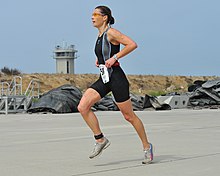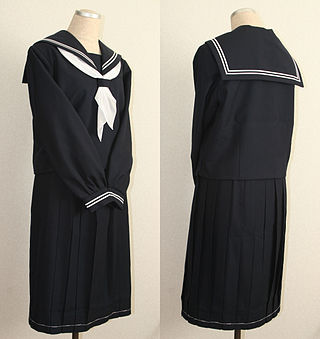
Japanese school uniforms are modeled on European-style naval uniforms. They were first used in Japan in the late 19th century, replacing the traditional kimono. Today, school uniforms are common in many Japanese public and private schools. The Japanese word for this type of uniform is seifuku (制服).
A suit is a set of garments with matching pieces, typically a jacket and trousers.
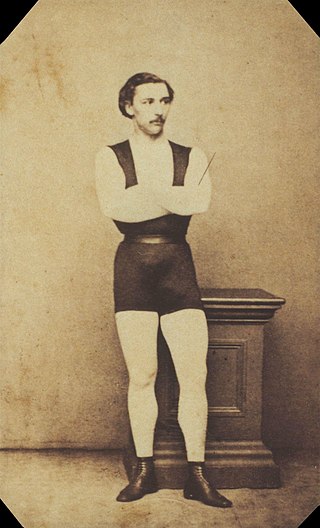
A leotard is a unisex skin-tight one-piece garment that covers the torso from the crotch to the shoulder. The garment was made famous by the French acrobatic performer Jules Léotard (1838–1870). There are sleeveless, short-sleeved, and long-sleeved leotards. A variation is the unitard, which also covers the legs. It provides a degree of modesty and style while allowing for freedom of movement.

A skin-tight garment is a garment that is held to the skin usually by elastic tension using some type of stretch fabric. Commercial stretch fabrics ('elastomerics') such as spandex or elastane came onto the market in 1962, and revolutionized many areas of the clothing industry. A wide variety of clothing may be made to be skin-tight, and it is common for clothing to be skin-tight for some uses, such as in stockings, bodystockings, swimsuits and women's bras.
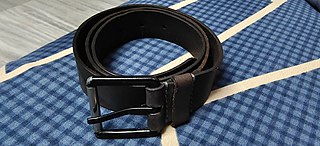
A belt is a flexible band or strap, typically made of leather, plastic, or heavy cloth, worn around the natural waist or near it. The ends of a belt are free; and a buckle forms the belt into a loop by securing one end to another part of the belt, at or near the other end. Often, the resulting loop is smaller than the hips. Belts come in many lengths because of the variety in waist sizes, and most belts can be adjusted at the buckle to suit the wearer's waist.

A sweater or pullover, also called a jersey or jumper, is a piece of clothing, typically with long sleeves, made of knitted or crocheted material that covers the upper part of the body. When sleeveless, the garment is often called a slipover, tank top, or sweater vest.
A catsuit is a one-piece form-fitting garment that covers the torso and the legs, and frequently the arms. They are usually made from stretchable material, such as lycra, chiffon, spandex, latex, or velour, but may use less elastic materials, such as leather or PVC. Catsuits frequently close by means of a zipper at the front or back. A catsuit is regarded as outerwear, but not normally street wear. Catsuits are also used for sexualization or other types of sexuality.

The Weekenders, also known as Disney's The Weekenders, is an American animated television series created by Doug Langdale that ran on February 26, 2000, with the last episode airing on February 29, 2004, spanning four seasons. It centers on the weekend life of four 12-year-old 7th graders: Tino, Lor, Carver, and Tish. The series originally aired on ABC and UPN, but was later moved to Toon Disney.

A jumpsuit is a one-piece garment with sleeves and legs and typically without integral coverings for feet, hands or head. The original jump suit is the functional one-piece garment used by parachutists.
Game of Death is an incomplete Hong Kong martial arts film, of which portions were filmed between September and October 1972, and was planned and scheduled to be released by 1973, directed, written, produced by and starring Bruce Lee. The project was paused to film and produce Enter the Dragon. For Game of Death, over 120 minutes of footage was shot. The remaining footage has since been released with Lee's original Cantonese and English dialogue, with John Little dubbing Lee's Hai Tien character as part of the documentary titled Bruce Lee: A Warrior's Journey. Much of the footage that was shot is from what was to be the climax of the film.
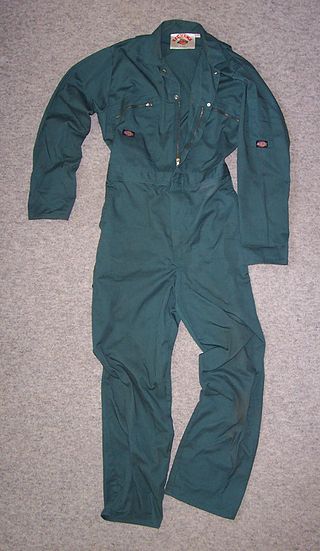
A boilersuit, also known as coveralls, is a loose fitting garment covering the whole body except for the head, hands and feet.
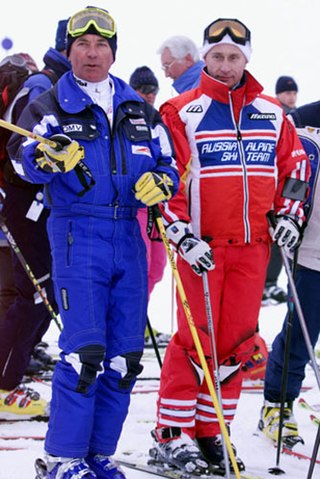
A ski suit is a suit made to be worn over the rest of the clothes when skiing or snowboarding. Ski suits made for more casual winter wear outdoors may also be called snowsuits and are often used by children as everyday outerwear in the winter season. Some suits are specifically made for snowboarders but most are used by either skiers or snowboarders regardless of the style.

A flight suit is a full-body garment, worn while flying aircraft such as military airplanes, gliders and helicopters. These suits are generally made to keep the wearer warm, as well as being practical, and durable. Its appearance is usually similar to a jumpsuit. A military flight suit may also show rank insignia. It is sometimes used by Special Forces as a combat uniform in close quarters battle or visit, board, search, and seizure situations, for its practicality.

Parachute pants, originally known as flight pants, are a style of trousers characterized by the use of nylon, especially ripstop nylon.

Kurdish traditional clothing, also known as Kurdish dress, refers to the folk costumes of the Kurdish people. The traditions typically vary across different regions and tribes of Kurdistan, but it has some common elements. Historically, Kurdish clothing was more complex and varied, but it has evolved to a simpler form over time. It is also prominently worn during festivals and special occasions such as Newroz.

A prison uniform is a set of standardized clothing worn by prisoners. It usually includes visually distinct clothes worn to indicate the wearer is a prisoner, in clear distinction from civil clothing.
Star Trek uniforms are costumes worn by actors portraying personnel of a fictitious Starfleet in various television series and films in the Star Trek science fiction franchise. During the various series, the costume design has often changed to represent different time periods and for reasons of appearance and comfort. Sometimes different styles were deliberately mixed to enhance the sense of time travel or alternative universes.

Clothing fetishism or garment fetishism is a sexual fetish that revolves around a fixation upon a particular article or type of clothing, a particular fashion or uniform, or a person dressed in such a style.

Rubber hose animation was the first animation style that became standardized in the American animation field. The defining feature is a curving motion that most animated objects possess, resembling the motion and physical properties of a rubber hose. While the style fell out of fashion by the mid-1930s, it has seen a renewed interest since the 2010s.

Vera Huppe Maxwell was an American pioneering sportswear and fashion designer.
